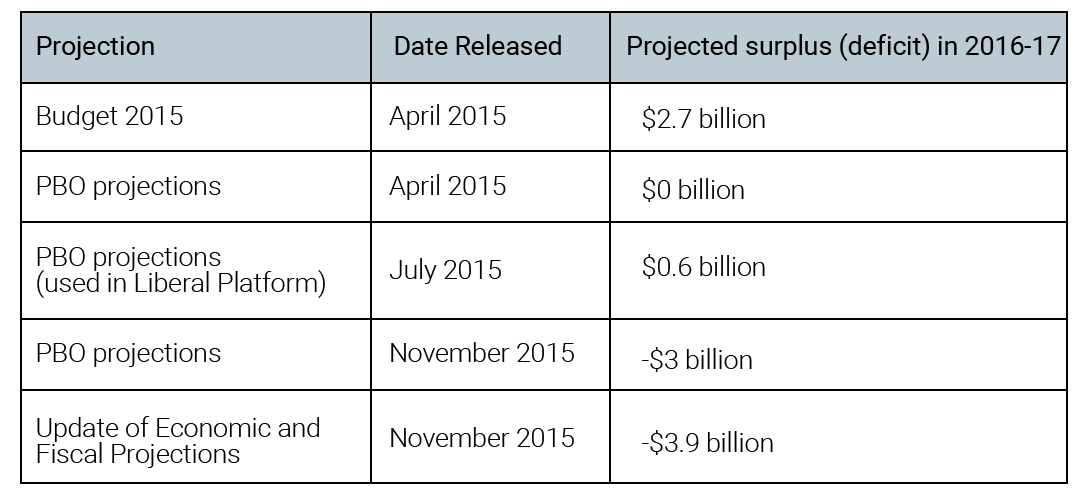With under 24 hours’ notice and released on a Friday, you could be certain the news from today’s fall Update of Economic and Fiscal Projections (UEFP) wasn’t going to be good. Nor was it surprising. The rosy picture painted in the April 2015 budget, the last time these figures were updated, was custom made to allow the Conservatives to claim they had slayed the deficit ahead of the October election. Never mind that the budget was released in the middle of a recession, or that its projections relied on oil falling to $54 per barrel in 2015 then rising to $80 by 2018, with economic growth in step. Oil is presently at $40 a barrel.
But the Liberals aren’t that interested in what happened this fiscal year (2015-16); they’re interested in the next one, starting in April 2016. That’s when their platform starts.
Table 1: 2016-17 Surplus (deficit) projections
 Notes: Includes contingency fund
Notes: Includes contingency fund
As shown in Table 1, the starting point from which to calculate the final deficit is a moving target on a rapid downward trajectory. The Liberal platform proposes $10.5 billion in net new spending in 2016-17, their first full year in power, so to figure out what the deficit would be, all you need to do is take the underlying projected surplus (deficit) from Table 1 and subtract that amount.
The Liberal platform used a starting surplus of $0.6 billion. Subtract $10.5 billion and you end up with a platform-based deficit of $9.9 billion. However, using the November UEFP starting deficit of $3.9 billion, the deficit becomes $14.4 billion.
All of this would be esoteric had the Liberals not also promised in the election campaign to carry a deficit of no more than $10 billion, which, based on the UEFP, they would now exceed by $4.4 billion. This will give critics room to claim the Liberals have painted themselves into a corner.
So what should the government do? As I see it, there are three options:
1. Implement the Liberal platform as is and ignore the $10 billion deficit ceiling
Differences in deficits of a few billion dollars are a political issue, not an economic one. A deficit would need to reach at least $20 billion before it got close to 1% of the size of Canada’s $2 trillion economy, and even then the impact on our relative debt would be insignificant. Obviously, a billion dollars is an inconceivable amount for an individual person, but for a country as large and prosperous as Canada, these are small amounts.Besides, the collapse in oil prices, and projections of slow growth for years to come, will require more federal involvement in the economy for many years to come.
2. Cut back platform promises
Since many of the items in the Liberal platform are also in our annual Alternative Federal Budget, I’m much more favourable to the first option than this one, which would require cutting roughly $4.4 billion worth of campaign promises. But there are ways to mitigate the damage.For example, the most obvious measure to cut would be the Liberals’ erroneously named “middle class tax cut,” which is really a tax cut for the upper middle class that does nothing for the actual middle class, not to mention lower middle class. This promise is worth about $3 billion, and since so few middle class taxpayers would see a noticeable benefit at tax time, there’s your deficit problem solved.
The Liberal government could also delay the creation of the proposed Canada Child Benefit, saving just under $4 billion, but leaving 300,000 children in poverty in the process. Not a very good trade.
Other than those two large programs, the Liberals would have to cut more than one item from their platform promises. The next largest items are the three infrastructure programs (at $1.7 billion each). After that, the Liberals would be looking at cutting swatches of smaller programs (five to 10 of them) to get the deficit under $10 billion. Broad cuts to their promises so early in a mandate seem unlikely.
3. Increase revenues
Governments can always decrease deficits by increasing revenues, a measure that has been out of favour federally for some time now. Given our shock at any changes in tax rates these days, it’s unlikely we will see any direct tax changes to shrink the deficit. However, the Liberal platform shows a willingness to take a look at federal “tax expenditures,” which regular Canadians would know better as tax loopholes, many of them custom built for Canada’s wealthy. The Liberal platform says the government would save $500 million in 2016-17 from closing tax loopholes, rising to $3 billion by 2019-20. Trudeau could accelerate that timetable if he is really desperate to shrink this deficit.So should we panic about the deficit? No. The best we can hope for is that the artificial deficit ceiling the Liberals have imposed on themselves will simply be ignored. If they figure they need to keep it for political reasons, they should either not implement their tax cut for upper middle class families or accelerate their timetable for closing tax loopholes.
David Macdonald is a senior economist with the Canadian Centre for Policy Alternatives. Follow him on Twitter @DavidMacCdn.






